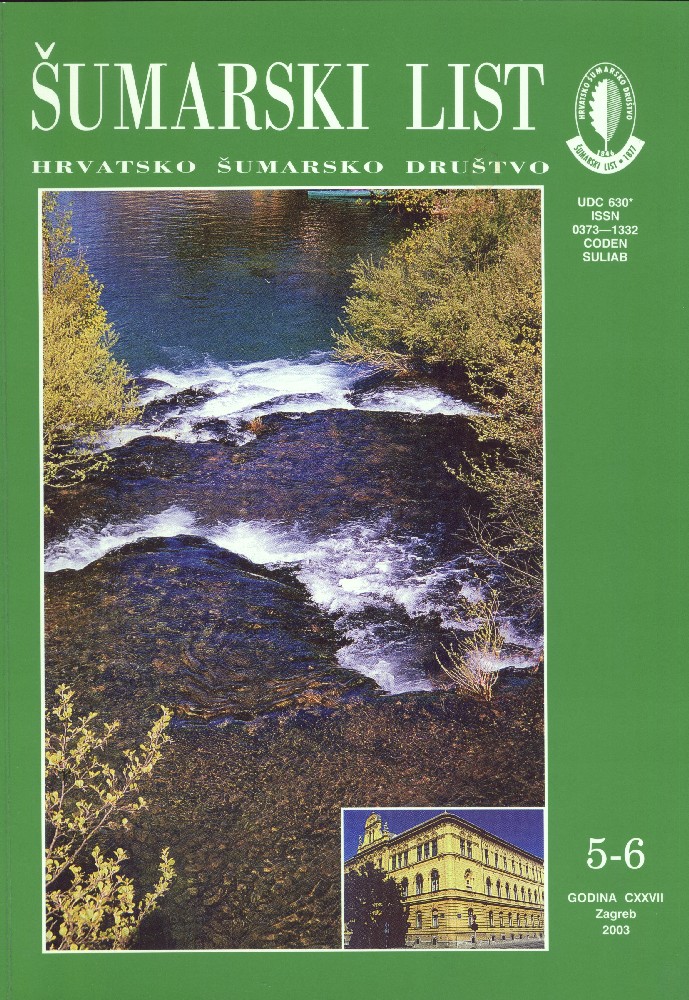
broj: 5-6/2003
pdf (28,7 MB) |
|
||||||||||||||
| UVODNI ČLANCI | ||
| Matić, S. | ||
| Some Problems Encountered by the Croatian Forestry in Today’s Economic, Social and Ecological Circumstances (from the Report at the 107th Annual Assembly of the Croatian Forestry Society in Županja). PDF | 211 | |
| Matić, S. | ||
| The Role of Forestry in the Protection of Drinking Water PDF HR EN | 217 | |
| IZLAGANJA NA ZNANSTVENIM I STRUČNIM SKUPOVIMA | ||
| Milković, I., Starčević, M., Pećarević, M. | UDK 630* 611 + 116 | |
| The Role of Forestry in the National Fresh Water Monitoring, Protection and Conservation Programme in Croatia pdf HR EN | 219 | |
| Prpić, B. | UDK 630* 263 + 181.3 + 48 | |
| The Effects of Technical Operations in the Area of Lowland Forests pdf HR EN | 230 | |
| Starčević, T. | ||
| Supplement to the topic: The Role of Forestry within the National Programme of Recording, Protection and Conservation of Croatian Fresh Waters PDF | 235 | |
| IZVORNI ZNANSTVENI ČLANCI | ||
| Šugar, I. | UDK 630* 17 (001) | |
| A Contribution to Croatian Terminology of Plant Classification pdf HR EN | 237 | |
| PRETHODNO PRIOPĆENJE | ||
| Medvedović, J., Martinović, J., Vranković, A. | UDK 630* 181.2 + 114 | |
| Continental Ecosystems of Croatia pdf HR EN | 249 | |
| PREGLEDNI ČLANCI | ||
| Glavaš, M. | UDK 630* 232.3 + 449 + 453 + 413 + 414 | |
| Plant Health Status and Protective Measures Taken in Forest Nurseries in 2002 pdf HR EN | 257 | |
| Summary: In 36 forest nurseries in Croatia a total of 25 mil. plants has been produced in 2002. Among broadleaves, 74 % were oak saplings, 18 % narrowleaved ash, 4 % beech and 4 % willows. Among conifers, 57 % were spruce plants, 29 % pines, 9 % other conifers and 5 % various horticultural species. Forest nurseries were checked against pest and diseases twice a year, sometimes more and in the year 2002 a total of 14 pathogenic fungal species and 18 insect pest species were recorded. Among pathogenic fungi Microsphaera alphitoides Griff. et Maubl. was the most important one. Drepanopeziza punctiformis Gremmen, Melampsora allii-populina Kleb., Fusarium oxysporum Schlecht and Rosellinia mycophila (Fr.:Fr) Sacc. were also highly significant. Among these, the last one was for the first time in Croatia. Among insect pests various species of leaf beetles recorded on poplars and Caliroa annulipes Klug. on oak saplings. In several nurseries damages from cockchafer larvae (Melolontha melolontha L.) were recorded. Horse-chestnut saplings were attacked by leaf miner Cameraria ohridella Deschka et Dimić, box by leaf mining midge Monarthropaplus buxi Laboulbene and planes by Corythuca ciliata Say. Other recorded fungi and insect pests were of much less significance. Protection measures were undertaken in all screened nurseries. Oak powdery mildew was treated in 13 nurseries with total number of 11 fungicides. Against insect pests on oak saplings 7 different insecticide formulations were applied. In poplar and willow nurseries large number of pesticides was applied. Treatment against dumping off of conifers was done in 7 and against dumping off of broadlives in 5 forest nurseries, with total of 10 pesticide formulations. Weeds were chemically suppressed in 11 nurseries with 13 herbicide formulations. Thanks to frequent health control and well performed control measures plants in forest nurseries are kept healthy and of good overall quality. Key words: nursery; plant; sapling; fungus; insect; weed; fungicide; insecticide; herbicide; treatment; protection | ||
| Oluić, M., Oluić, D. | UDK 630* 582 + 583 | |
| Land Use and Land Cover Mapping of Istria According to CORINE Programme pdf HR EN | 269 | |


